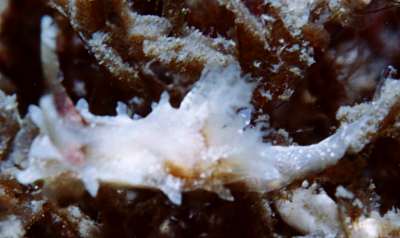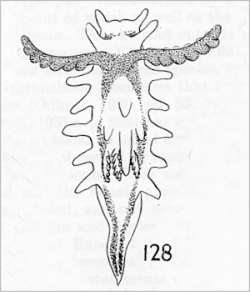

Okenia evelinae
Marcus, 1957
Order: NUDIBRANCHIA
Suborder: DORIDINA
Superfamily: ANADORIDOIDEA
Family: Goniodorididae
DISTRIBUTION
West Atlantic - Brazil, Florida
PHOTO
Upper: Live animal from Lake Worth Lagoon, Florida, USA. Depth: 15 feet. January 2004. Approx 3/8 inch. Photo: Judy Townsend.
Lower: Okenia evelinae. Marcus, 1957 - Fig 128.
Okenia evelinae is known only from the original description from Brazil, the description being based on 23 specimens, the largest being 8mm long alive. They were found on the arborescent bryozoan Amathia convoluta, and the colour was described as:
".. integument white and contains refractive granules on the back. The tissues of the inner organs are yellow, the liver dark yellow. The dorsal appendages, the gills and the borders of the foot are pure white. The rhinphores are violet, and the same colour occurs on the sides, the tail, and in small quantities on the back of full grown animals."
Marcus also described 4 dorsal papillae in front of the gills, 2 median and 2 lateral, and a series of 5 or 6 "blunt peg-shaped appendages on each side" along the mantle edge. Although the dorsal papillae are not clear in Judy Townsend's photo, the other features of the external shape and colour, as described by Marcus, are. In this photo, the purple markings on the body, as described by Marcus, are replaced by a brownish colour, but as the purple on the rhinophores merges into brown, this is obviously a variable character in this species.
Clark (1984) considers O. evelinae to be a synonym of O. zoobotryon and this approach has been followed by later authors. As I discuss in a separate message, I disagree with that decision.
Characters distinguishing the two species include O. zoobotryon feeding on Zoobotryon [many records] while O. evelinae apparently feeds on Amathia sp. [1 report]. In colour O. zoobotryon is essentially translucent with small brown spots, while O. evelinae is translucent white with opaque white spots, and has purple rhinophores [or purplish brown] and a symmetrical pattern of the same colour on the body. The mantle papillae in O. zoobotryon have a narrow stalk and a rounded terminal bulb while those of O. evelinae are short and triangular in shape.
References:
• Clark, K. B. (1984) New records and synonymies of Bermuda opisthobranchs (Gastropoda). The Nautilus, 98(2): 85-97.
• Edmunds, M. & Just, H. (1985) Dorid, dendronotoid and arminid nudibranchiate Mollusca from Barbados. Journal of molluscan Studies, 51(1): 52-63.
• Marcus, Er. (1957) On Opisthobranchia from Brazil (2). Journal of the Linnean Society of London, Zoology, 43(292): 390-486.
• Redfern. C., (2001) Bahamian Seashells: a Thousand Species from Abaco, Bahamas. Bahamianseashells.com Inc: Boca Raton. 1-280.
• Smallwood, W.M. (1910). Notes on the Hydroids and Nudibranchs of Bermuda. Proc. Zool. Soc. London. 1: 137-145
• Smallwood, W. M. (1913) Polycerella zoobotryon (Smallwood). Proceedings of the American Academy of Arts & Sciences, 47(16): 609-630.
• Valdes, A. & Ortea, J. (1995) Revised taxonomy of some species of the genus Okenia Menke, 1830 (Mollusca: Nudibranchia) from the Atlantic Ocean, with the description of a new species. The Veliger, 38(3): 223-234.
Rudman, W.B., 2004 (January 28) Okenia evelinae Marcus, 1957. [In] Sea Slug Forum. Australian Museum, Sydney. Available from http://www.seaslugforum.net/find/okenevel
Related messages
Bryozoan of Okenia evelinae
February 11, 2004
From: Linda Ianniello

Dr. Bill, as a continuation of your message [#12129] about the food of Okenia evelinae, here is a shot of the slug on the bryozoan. I did not send it in earlier because it is such a poor shot of the slug, but is a decent shot of the bryozoan. I hope this helps further the case that this is a separate species.
Location: Lake Worth Lagoon, Florida, SE coast of USA. February, 2004
Regards,
Linda I.
lindai@us.ibm.com
Ianniello, L., 2004 (Feb 11) Bryozoan of Okenia evelinae. [Message in] Sea Slug Forum. Australian Museum, Sydney. Available from http://www.seaslugforum.net/find/12143Thanks Linda,
Bill Rudman
Food of Okenia evelinae
February 5, 2004
From: Bill Rudman

PHOTO: Lake Worth Lagoon, Southeast coast of Florida, USA. Depth: 15 feet, 1 February 2004. Photo: Linda Ianniello.
This is just a cross-reference to my comments on Linda Ianniello's message on Polycera hummi, in which she mentions, and includes a photo of the bryozoan on which she found both Polycera hummi and Okenia evelinae.
I am not an expert on bryozoans but I am pretty sure this is Amathia distans Busk, 1886, which has a circumtropical distribution and is a common in the western Atlantic. It is found from North Carolina to Brazil. The way the zooids are arrange in slightly curved double rows is typical of the species. There is an illustration on the Smithsonian Marine Station at Fort Pierce website at
www.sms.si.edu/irlspec/Amathi_distan.htm
You may remember in my discussion of Okenia evelinae that I noted that Marcus reported it feeding on Amathia convoluta. My understanding is that true A. convoluta is a South Pacific species, so it is quite possible that Marcus's record is a misidentification for Amathia distans. Your bryozoan is quite different from Zoobotryon which has almost transparent stalks and irregularly arranged zooids. The presence of a specimen of Okenia evelinae on this bryozoan, adds further weight to my suggestion that it is not a synonym of Okenia zoobotryon which has only been reported from the bryozoan Zoobotryon.
Best wishes
Bill Rudman
Okenia evelinae f rom Florida
January 28, 2004
From: Linda Ianniello


Dr. Bill,
attached is a shot of another mystery from the east coast of Florida. I'm sorry the picture is not very good, but hopefully it is good enough to identify, since it appears to be something that is not already on the forum. It was found in Lake Worth Lagoon on a night dive, at a depth of about 15 feet, in January 2004. It was very small, about 3/8 inch. My friend Judy Townsend took this shot, since she had the better set-up to make an attempt.
The best I can do is possibly an Okenia zoobotryon? Looking at a photo I have from Kerry Clark's web pages it appears to be similar.
As usual, thanks for the help, and for maintaining such a great Forum.
Regards,
Linda I.
lindai@us.ibm.com
Ianniello, L., 2004 (Jan 28) Okenia evelinae f rom Florida. [Message in] Sea Slug Forum. Australian Museum, Sydney. Available from http://www.seaslugforum.net/find/11929Dear Linda,
Thanks for another interesting find. Your animal does look quite like Okenia zoobotryon, and is definitely of the same genus, but I suspect it is a species described from Brazil, Okenia evelinae Marcus, 1957, and probably not reported since. Kerry Clark (1984) and Valdes & Ortea (1995) consider O. evelinae to be a synonym of O. zoobotryon but as I discuss in a separate message I suspect this is a separate species.
Your animal fits Marcus's description of the living animal very well. He described it as being all white with 'refractive granules' on the back, and with violet rhinophores. He also describes, and illustrates a pattern of violet on the body in some animals which matches the brown pattern in Judy Townsend's photo in your message. A streak behind each rhinophore, a band on each side of the gills and a band down each side of the 'tail'.
Both Marcus's animal and yours have abnormally large rhinophores and tapering, almost triangular papillae along the mantle edge.
Even without looking at the anatomy, it is clearly different from Okenia zoobotryon which has been described in some detail by a number of authors. It is indeed an intersting find.
Best wishes
Bill Rudman
Rediscovery of Okenia evelinae
January 28, 2004
From: Bill Rudman


PHOTOS:. Upper: Live animal from Lake Worth Lagoon, Florida, USA. Depth: 15 feet. January 2004. Approx 3/8 inch. Photo: Judy Townsend.
Lower: Okenia evelinae. Marcus, 1957 - Fig 128.
The photo of an Okenia from Florida in Linda Ianiello's message is almost certainly Okenia evelinae. The species is known only from the original description from Brazil, the description being based on 23 specimens, the largest being 8mm long alive. They were found on the arborescent bryozoan Amathia convoluta, and the colour was described as:
".. integument white and contains refractive granules on the back. The tissues of the inner organs are yellow, the liver dark yellow. The dorsal appendages, the gills and the borders of the foot are pure white. The rhinphores are violet, and the same colour occurs on the sides, the tail, and in small quantities on the back of full grown animals."
Marcus also describes 4 dorsal papillae in front of the gills, 2 median and 2 lateral, and a series of 5 or 6 "blunt peg-shaped appendages on each side" along the mantle edge. Although the dorsal papillae are not clear in Judy Townsend's photo, the other features of the external shape and colour, as described by Marcus, are. In this animal, the purple markings on the body, as described by Marcus, are replaced by a brownish colour, but as the purple on the rhinophores merges into brown, this is obviously a variable character in this species.
Clark (1984) considers O. evelinae to be a synonym of O. zoobotryon considering the colour differences [purple rhinophores] and size and number of radular rows to be unimportant and 'may be due to variations in diet and size'.
I find this a rather circular argument. Zoobotryon pellucida is the only food on which 'typical' O. zoobotryon has been found on. While it might be possible to suggest that specimens living on a different bryozoan, in this case Amathia, might have different colour and radular morphology, there is no evidence to support this theory in any other species. We normally assume that animals feeding on different organisms and showing different morphologies are different species, unless proven otherwise. One significant difference not discussed by Clark (1984) is the shape of the papillae around the mantle edge. In O. evelinae they are short and triangular, tapering to a rounded tip while in O. zoobotryon they have a thin stalk ending in a swollen rounded tip, described by Valdes & Ortea (1995) as like a 'chess pawn'.
Valdes & Ortea (1995) in the revision of some Atlantic species have followed Clark in considering O. evelinae to be a synonym of O. zoobotryon. The descriptions of O. zoobotryon by various authors (Clark,1984; Edmunds, M. & Just, H.,1985; Redfern. C., 2001; Smallwood, W. M., 1913; Valdes & Ortea,1995)clearly define that species. The animal in Linda Ianiello's message does not fit that description at all, but meets the original description of Okenia evelinae in all essential external features, and suggest that it is a good species, quite distinct from O. zoobotryon.
References:
• Clark, K. B. (1984) New records and synonymies of Bermuda opisthobranchs (Gastropoda). The Nautilus, 98(2): 85-97.
• Edmunds, M. & Just, H. (1985) Dorid, dendronotoid and arminid nudibranchiate Mollusca from Barbados. Journal of molluscan Studies, 51(1): 52-63.
• Marcus, Er. (1957) On Opisthobranchia from Brazil (2). Journal of the Linnean Society of London, Zoology, 43(292): 390-486.
• Redfern. C., (2001) Bahamian Seashells: a Thousand Species from Abaco, Bahamas. Bahamianseashells.com Inc: Boca Raton. 1-280.
• Smallwood, W.M. (1910). Notes on the Hydroids and Nudibranchs of Bermuda. Proc. Zool. Soc. London. 1: 137-145
• Smallwood, W. M. (1913) Polycerella zoobotryon (Smallwood). Proceedings of the American Academy of Arts & Sciences, 47(16): 609-630.
• Valdes, A. & Ortea, J. (1995) Revised taxonomy of some species of the genus Okenia Menke, 1830 (Mollusca: Nudibranchia) from the Atlantic Ocean, with the description of a new species. The Veliger, 38(3): 223-234.
Bill Rudman
Rudman, W.B., 2004 (Jan 28) Rediscovery of Okenia evelinae. [Message in] Sea Slug Forum. Australian Museum, Sydney. Available from http://www.seaslugforum.net/find/12043